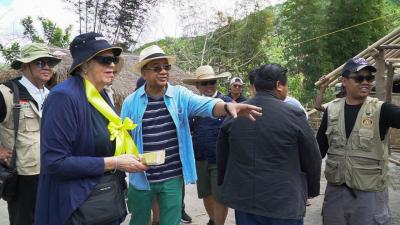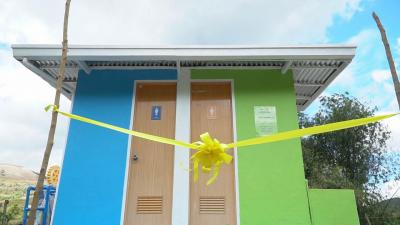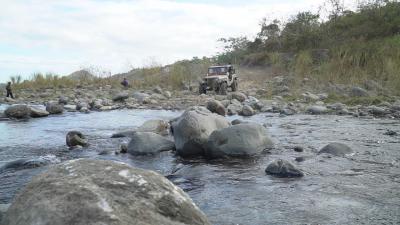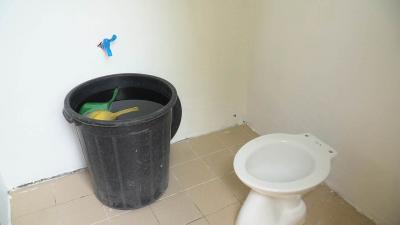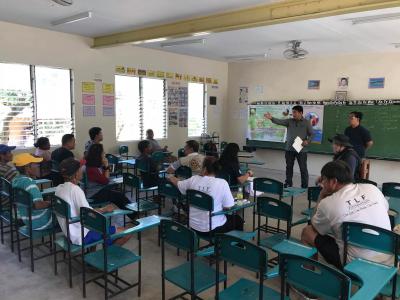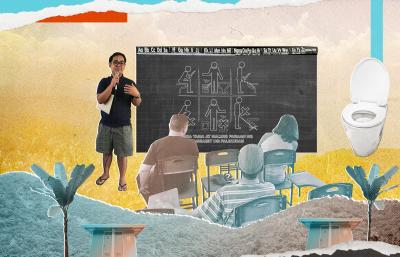
Philippine WASH project delivers toilets, hygiene education to villages
Rotary gets the job done where others failed
In 1991, Mount Pinatubo erupted after 600 years of inactivity and destroyed homes and farms, displacing many indigenous Aeta living in the highlands of central Luzon, Philippines.
While Aeta can refer to several different related ethnic groups, the Aeta here are descendants of Mag-Antsi, who following the eruption, were resettled by the government. Since then, many have returned to their ancestral lands to rebuild and reestablish their communities.
Lack of sanitation where least expected
The world governments have been making progress on increasing access to safe drinking water, but progress on sanitation lags. People lack basic facilities in places you might not expect.
The roughly 43 families in Flora and 79 in nearby Kawayan make a living farming. While Aeta in other areas have been granted title to their ancestral land by the government, these Aeta have seen their lands shrink and their source of livelihood suffer as people from the lowlands staked competing claims during their resettlement years.
Like more than 10 million households in the Philippines, they lack sanitation facilities. The Philippines government has made progress in extending water to its 109 million inhabitants, but long-term plans to expand sanitation are running behind, especially in rural regions. This reduced access to personal hygiene exposes communities to diseases like diarrhea and cholera, and can lead to decreased school attendance, malnutrition, poor oral health, and fear of violence in women who must practice personal hygiene outdoors, according to a report by UNICEF.
-
1000.00
Number of children who die each day due to preventable water and sanitation-related diarrheal diseases.
-
892.00 million
Number of people who continue to practice open defecation.
Source: United Nations
To combat these problems, the Rotary Club of Intramuros-Manila developed a water, sanitation, and hygiene (WASH) project that installed 25 toilets in the Aeta communities of Flora and Kawayan and three in Babo. Rotary members made visits to the community to learn about and understand current hygiene practices, willingness to work on the project, and the communities desire for toilets.
Before a single brick was shipped, Rotary developed friendships and gained buy-in from the community. Rotary was able to leverage an existing profile of Flora and Kawayan to guide the project, including information on race, history, socio-economic conditions, family units, source of livelihood, and means of transportation.
Behavior change is hard. You’re asking people to do something different from what they were comfortable doing before.
“On our first visit, one of the leaders said that nongovernment organizations and politicians had visited them often, promising to build toilets,” recalls Floren Naguit, project manager and member of the Intramuros Rotary Club. “But none had ever been built.” Until now.
Work began in Flora in early 2018 during the dry season, December through April, when roads are most passable. Together with their international partner, the Rotary Club of Batemans Bay, Australia, the club organized three-person work crews and local volunteers to haul materials by Jeep and carabao-pulled carts up mountain roads and across 26 rivers.
Septic tanks were installed, foundations set, walls and roofs built, tiles laid, toilet bowls inserted, solar lamps added, and use and care signs hung. Construction in Kawayan began after Flora was completed, with the total project dedicated in early 2020.
The project paid local teachers, hired by the government, a small stipend to lead three small workshops for clusters of two to three families, and include education on safe hygiene in their lesson plans to encourage behavior change.
“Behavior change is hard,” says Mark Balla, vice chair of the Water and Sanitation Rotary Action Group, “You’re asking people to do something different from what they were comfortable doing before.” But without it, people can slip back into past habits and toilets can fall into neglect or disrepair.
Perhaps most importantly, Balla stresses the need for patience.
“You are going to get imperfect results. There are no perfect projects,” he said. “We need to understand that we are striving for continual improvement.”
Knowing that monitoring and measurement are critical, the Rotarians performed follow up surveys with the Aeta, asking questions about toilet use and handwashing behavior.
Although visits were suspended in early 2020 due to the COVID-19 pandemic, and then from September to December when the rainy session makes roads impassable, they are scheduled to resume in 2021.
Learn more about Rotary’s work in water, sanitation, and hygiene.
Related content
What it takes to have a sustainable WASH project
In communities with no services, incremental steps can go a long way

